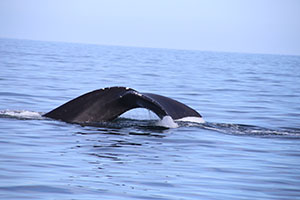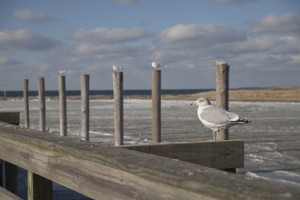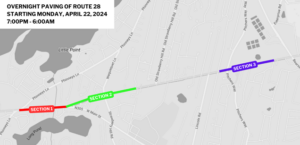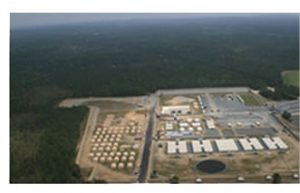
The tail of one of the right whales briefly sighted off Martha’s Vineyard Feb. 21. Photo credit: NOAA Fisheries/Pete Duley, NEFSC. Images collected under MMPA research permit #17355
BARNSTABLE – A yearlong study by the New England Aquarium is underway to help mitigate the effects that construction of wind farms south of Martha’s Vineyard may have on marine animals.
Three wind farms are currently planned for the area and the study will primarily focus on the impacts the construction could have on critically endangered North Atlantic right whales.
“The goal is to make sure that if developments move forward we can do it in the most responsible and environmentally sound manner possible,” said Bill White, the senior director of offshore wind for the Massachusetts Clean Energy Center.
The study, which is being conducted by the aquarium, the Woods Hole Oceanographic Institution and the Center for Coastal Studies, will document the whales’ occurrences and their feeding habits.
The right whales are the most endangered large whale species in the world with an estimated population of around 525.
An aerial survey team spotted a record 163 individual whales in Cape Cod Bay during a single day last week. The number is about 30 percent of the species population. A 1-year-old female was found dead in the bay and a cause of death is still being investigated, but initial necropsy results showed bruising from blunt trauma.
The whales come to the area during the spring to feed.
“My sense is that this information will help inform whether the federal government will require time of year restrictions,” White said. “So when construction is taking place there could be a time of year restriction so that when the North Atlantic right whales are coming through the area there would be no construction.”
The study will include aerial surveys and boat-based research on the whales’ food source.
MassCEC will also continue collecting data with WHOI and the University of Rhode Island using acoustic buoys.
“We have had actually nine underwater acoustic buoys deployed throughout this wind planning area over the last several years again detecting the presence of these endangered animals,” White said. “That has been helping us inform the science.”
White said all of the data collected will be used to inform the federal government when they issue permits for the offshore wind projects.
“It’s meant to inform what types of mitigation, what types of actions that developers should take in order to prevent negative impacts to these marine animals,” White said.
By BRIAN MERCHANT, CapeCod.com NewsCenter
























